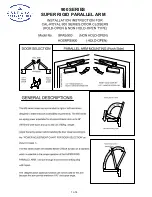
6
Eastwood Technical Assistance: 800.343.9353 >> [email protected]
ELECTROMAGNETIC FIELDS CAN BE A HEALTH HAZARD!
• The electromagnetic field that is generated during arc welding may interfere with various electrical and electronic devices such as
cardiac pacemakers. Anyone using such devices should consult with their physician prior to performing any electric welding operations.
• Exposure to electromagnetic fields while welding may have other health effects which are not known.
ARC RAYS CAN INJURE EYES AND BURN!
• Arc rays produce intense ultraviolet radiation which can burn exposed skin and cause eye damage. Use a shield with the proper filter
(a minimum of #11) to protect your eyes from sparks and the rays of the arc when welding or when observing open arc welding
(see ANSI Z49.1 and Z87.1 for safety standards).
• Use suitable clothing made from durable flame-resistant material for skin protection.
• If other persons or pets are in the area of welding, use welding screens to protect bystanders from sparks and arc rays.
FUMES AND WELDING GASES CAN BE A HEALTH HAZARD!
• Fumes and gasses released during welding are hazardous. Do not breathe fumes that are produced by the welding operation.
• Prolonged inhalation of welding fumes above safety exposure limits can injure the lungs and other organs.
• Use enough ventilation and/or exhaust at the arc to keep fumes and gases from your breathing area.
• Use an OSHA approved respirator when welding in confined spaces or where there is inadequate ventilation.
• Never weld coated materials including but not limited to: cadmium plated, galvanized, lead based paints.
BUILDUP OF GAS CAN INJURE OR KILL!
• Shut off gas supply when not in use.
• Provide adequate ventilation.
• Do not weld in confined areas.
• Always turn your face away from valve outlet when opening cylinder valve.
CYLINDERS CAN EXPLODE IF DAMAGED!
Shielding gas cylinders contain gas under high pressure. If damaged, a cylinder can explode. As gas cylinders are a normal component of the
welding process, use extra care to handle them carefully.
• Protect compressed gas cylinders from excessive heat, mechanical shocks, physical damage, slag, open flames, sparks and arcs.
Keep away from any welding or other electrical circuits.
• Install cylinders in an upright position by securing to a specifically designed rack, cart or stationary support to prevent falling or
tipping over.
• Never weld on a pressurized cylinder or explosion will occur.
• Use only correct shielding gas cylinders, regulators, hoses and fittings designed for the specific application; maintain them and all
related components in good condition.
• Keep protective cap in place over valve except when cylinder is in use.
• Use proper equipment, procedures and have adequate help when moving or lifting cylinders.
SAFETY INFORMATION







































